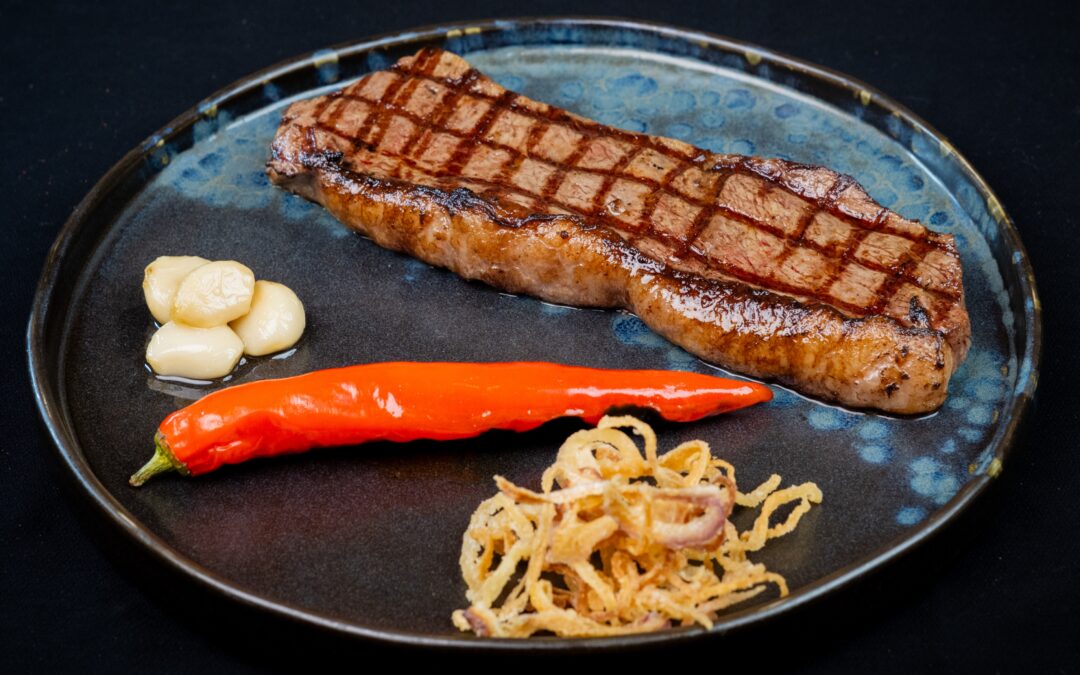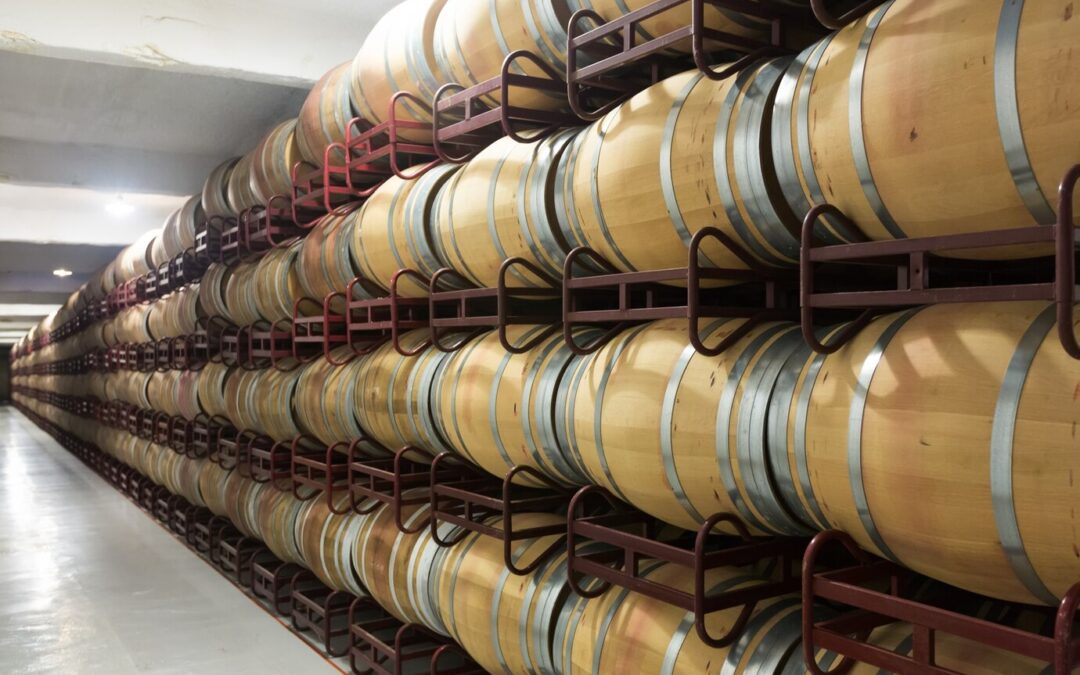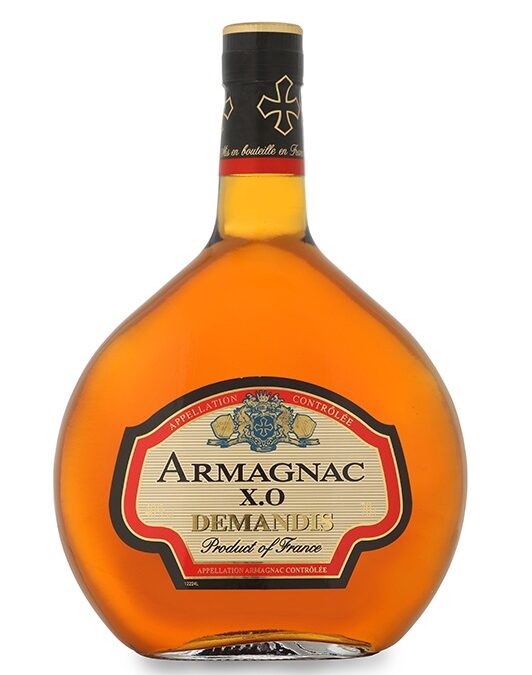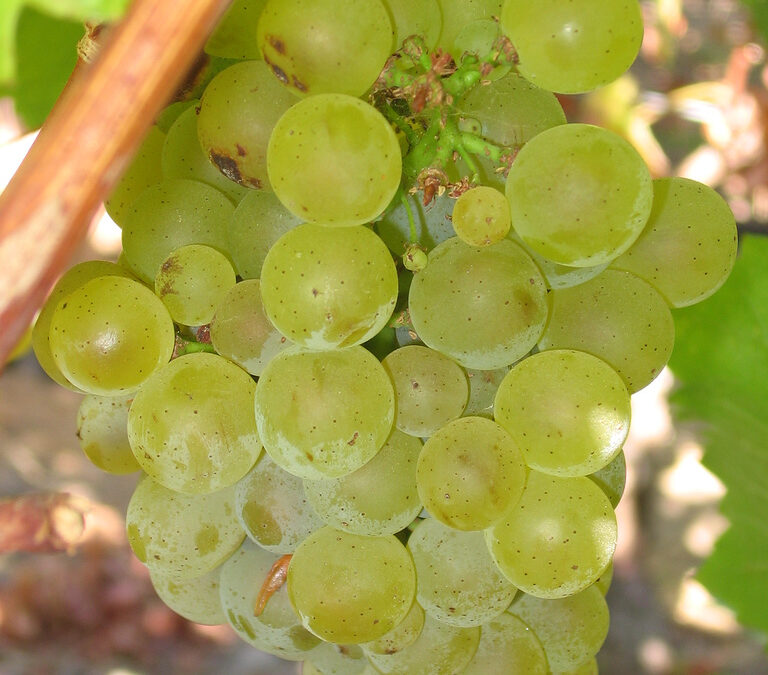
by Ross Kingsley | Mar 9, 2025 | KNOWLEDGE: MEAT ESSENTIALS
When it comes to ordering steak, one common dilemma is whether to opt for cuts that are “on the bone” or those that are served boneless. While both have their merits, the choice often boils down to presentation and value for money.
The Flavor Factor
The primary reasons people choose bone-in steaks is their belief that the bone enhances flavor. During the cooking process, the bone marrow can release subtle umami-rich juices that infuse the meat, adding depth to its taste. Cuts like T-bone or ribeye on the bone are often touted for their flavor profiles. However, this effect is not as dramatic as some might think. Most of the flavor enhancement occurs near the bone, leaving much of the meat unaffected.
Cooking Experience
If cooked professionally, bone-in steaks can retain heat better due to the thermal properties of the bone. This can help the steak cook more evenly and help retain its juiciness. However, this also makes cooking trickier for the uninitiated, as the meat closest to the bone can take longer to reach the desired doneness.
The Cost Conundrum
While bone-in steaks might look impressive on the plate, they often come with a hidden cost: you’re paying premium steak prices for the weight of the bone. A portion of your hard-earned money goes toward something that, for most people, is inedible and often relegated to being a treat for the family dog. By opting for boneless cuts, you’re ensuring that every gram you pay for is edible meat, making it the more economical choice.
The Verdict
Bone-in steaks are ideal if you value the aesthetic and vague potential flavor boost. However, if you prefer practicality, boneless cuts offer better value without compromising on quality. At Churrasco Phuket Steakhouse, we have made a conscious decision not to offer any bone-in steaks. This ensures we provide full value for money, focusing solely on superb cuts of steak that deliver an exceptional dining experience. The choice ultimately depends on what matters most to you: flavor, presentation, or cost.
Image Credit: https://churrascophuket.com/menus/ (Sirloin, Page 17)
_ _ _
© CHURRASCO PHUKET STEAKHOUSE / ALL RIGHTS RESERVED
>>> Reprinting, reposting & sharing allowed, in exchange for a backlink and credits <<<
Churrasco Phuket Steakhouse serves affordable Wagyu and Black Angus steaks and burgers. We are open daily from 12noon to 11pm at Jungceylon Shopping Center in Patong / Phuket.
We are family-friendly and offer free parking and Wi-Fi for guests. See our menus, reserve your table, find our location, and check all reviews here:
https://ChurrascoPhuket.com/
#Churrascophuket #jungceylon #phuketsteakhouse #affordablewagyu #wagyu

by Ross Kingsley | Mar 9, 2025 | WINES: UNCORKING THE MYSTERY
The process of winemaking is as much about art as it is about science, and one of the key elements in shaping a wine’s flavor is the barrel used during aging. Wine barrels are more than just storage vessels; they impart unique characteristics to the wine, enhancing its complexity, aroma, and taste. Let’s explore the different types of wine barrels and their influence on the final product.
Oak Barrels: The Gold Standard
When people think of wine barrels, oak is often the first material that comes to mind. Oak barrels are highly valued in winemaking due to their ability to add flavors such as vanilla, spice, and caramel. They also contribute to the wine’s texture and structure.
Oak barrels come primarily in two varieties: American and French. American oak barrels are known for their bold influence, providing sweeter and more pronounced flavors like coconut and vanilla. They are widely used for wines like Zinfandel and Cabernet Sauvignon. On the other hand, French oak barrels are more subtle, adding delicate flavors like toasted almonds and spices, making them ideal for premium Chardonnay or Pinot Noir.
European Oak Variants
Beyond French oak, other European oak species, such as Hungarian or Slavonian oak, are gaining popularity. Hungarian oak is similar to French oak but tends to be more affordable, offering a balance of flavor and structure. Slavonian oak, originating from Croatia, is often used in traditional Italian winemaking for wines like Barolo and Chianti. It imparts less pronounced flavors, allowing the fruit to shine while subtly enhancing the wine.
Alternative Materials
While oak is dominant, some winemakers experiment with other types of wood. Acacia barrels, for instance, are occasionally used for white wines. They enhance floral aromas without adding the typical oak flavors, making them a choice for delicate varietals.
Chestnut barrels, though less common, are part of winemaking traditions in Italy and Portugal. They allow more oxygen interaction than oak, which can soften tannins in red wines.
The Role of Aging and Toasting
The impact of a barrel isn’t solely about the type of wood but also its preparation. Toasting levels—light, medium, or heavy—can significantly influence the wine. Lighter toasting preserves more of the wood’s natural flavors, while heavier toasting introduces smokier, spicier notes.
Ultimately, the choice of barrel depends on the winemaker’s vision and the characteristics they wish to emphasize. Whether crafted in French oak or acacia, each barrel type contributes its signature to the art of winemaking, ensuring a diverse range of flavors for wine lovers to enjoy.
Image Credit: https://freepik.com
_ _ _
© CHURRASCO PHUKET STEAKHOUSE / ALL RIGHTS RESERVED
>>> Reprinting, reposting & sharing allowed, in exchange for a backlink and credits <<<
Churrasco Phuket Steakhouse serves affordable Wagyu and Black Angus steaks and burgers. We are open daily from 12noon to 11pm at Jungceylon Shopping Center in Patong / Phuket.
We are family-friendly and offer free parking and Wi-Fi for guests. See our menus, reserve your table, find our location, and check all reviews here:
https://ChurrascoPhuket.com/
#Churrascophuket #jungceylon #phuketsteakhouse #affordablewagyu #wagyu

by Ross Kingsley | Mar 9, 2025 | LIQUORS: LIFT YOUR SPIRITS
Armagnac is France’s oldest brandy, a spirit that has remained somewhat under the radar compared to its more famous cousin, Cognac. Produced in the Gascony region of southwestern France, it boasts it’s own traditions and production methods, and provides a complex flavor profile that sets it apart from other brandies.
A Rich History
Armagnac’s roots trace back over 700 years, making it one of Europe’s oldest distilled spirits. Historical records indicate its presence as early as the 14th century, when it was used medicinally before evolving into a sought-after drink. The region’s winemaking tradition predates even Cognac’s, and distillation methods likely arrived through a mix of Moorish, Roman, and medieval alchemical influences.
Despite its long history, Armagnac never achieved the same level of global commercial success as Cognac. The reasons lie partly in logistics—Cognac, with its proximity to the Atlantic, had easy access to export markets, while Armagnac remained more of a local treasure. This relative obscurity, however, has helped it maintain a level of artisanal craftsmanship that still defines the category today.
The Appellation and Production Process
Armagnac comes from three primary appellations: Bas-Armagnac, known for elegant and fruity expressions; Ténarèze, which produces fuller-bodied spirits that age well; and Haut-Armagnac, a lesser-known sub-region with small-scale production.
Unlike Cognac, which is distilled twice in pot stills, Armagnac is typically distilled once using a continuous column still. This single distillation retains more character from the original wine, resulting in a richer, fuller-bodied spirit. Aging takes place in local black oak barrels, which impart robust flavors and accelerate the spirit’s evolution.
Key Terminology
Like Cognac, Armagnac uses aging classifications: VS (Very Special) for at least one year in oak, VSOP (Very Superior Old Pale) for four years, XO (Extra Old) for ten years, and Hors d’Âge, meaning the blend’s youngest component is at least ten years old. Vintage Armagnacs, distilled in a single year and bottled decades later, are highly prized.
Comparing Armagnac and Cognac
While both are French brandies, their differences are striking. Cognac is known for its smoother, more polished profile due to double distillation and the use of Limousin oak barrels. Armagnac, by contrast, is richer, earthier, and more rustic, often featuring intense notes of dried fruits, prunes, spices, and roasted nuts.
The Producers Keeping Tradition Alive
Some of Armagnac’s most renowned houses—such as Château de Laubade, Delord, Darroze, and Janneau—continue to uphold the region’s legacy. Other respected names include Laberdolive, Castarède, and Baron de Sigognac, each offering distinct styles that reflect the terroir and craftsmanship behind this unique spirit. Churrasco Phuket Steakhouse offers the excellent value-for-money Armagnax XO Demandis, supplied by Slaur Sardet in Le Havre, France.
For those seeking a bold alternative to Cognac, Armagnac delivers a depth of character that rewards exploration.
Image Credit: https://slaur.com
_ _ _
© CHURRASCO PHUKET STEAKHOUSE / ALL RIGHTS RESERVED
>>> Reprinting, reposting & sharing allowed, in exchange for a backlink and credits <<<
Churrasco Phuket Steakhouse serves affordable Wagyu and Black Angus steaks and burgers. We are open daily from 12noon to 11pm at Jungceylon Shopping Center in Patong / Phuket.
We are family-friendly and offer free parking and Wi-Fi for guests. See our menus, reserve your table, find our location, and check all reviews here:
https://ChurrascoPhuket.com/
#Churrascophuket #jungceylon #phuketsteakhouse #affordablewagyu #wagyu

by Ross Kingsley | Mar 9, 2025 | DECODING GRAPES: FROM VINES TO VINTAGE
Sauvignon Blanc, one of the most distinctive and widely planted white grape varieties, boasts a rich history and remarkable versatility. Renowned for its crisp and aromatic qualities, this grape has become a favorite among wine enthusiasts around the globe.
Origins and History
Sauvignon Blanc originates from the Bordeaux region of France, where it was historically blended with Sémillon to produce iconic dessert wines like Sauternes. Its name is derived from the French words “sauvage” (wild) and “blanc” (white), reflecting its early presence as a wild vine. Genetic studies have also revealed that Sauvignon Blanc is a parent to Cabernet Sauvignon, when crossed with Cabernet Franc.
The grape gained widespread recognition in the Loire Valley, where it flourishes in appellations like Sancerre and Pouilly-Fumé. These regions are celebrated for their pure expressions of Sauvignon Blanc, showcasing bright acidity, minerality, and notes of citrus and green apple.
Famous Wines and Styles
Sauvignon Blanc produces an array of wine styles, each reflecting the terroir and winemaking techniques. In the Loire Valley, it’s known for elegant and zesty wines, often with flinty, smoky undertones. Meanwhile, in Bordeaux, it’s frequently blended with Sémillon to create balanced and complex dry whites.
New Zealand has also made a significant mark on the Sauvignon Blanc world stage, particularly in Marlborough. These wines are vibrant and intensely aromatic, bursting with tropical fruit flavors, passionfruit, and herbaceous notes. The success of Marlborough Sauvignon Blanc has catapulted the grape to international fame, making it synonymous with bright, bold expressions.
In California, winemakers often experiment with oak-aged versions, producing what is known as Fumé Blanc. This style emphasizes texture and complexity, adding depth to the grape’s naturally vivid profile.
Geographical Reach
While its roots lie in France, Sauvignon Blanc has spread to nearly every wine-producing region in the world. New Zealand and France remain its most renowned producers, but the grape thrives in diverse climates, from Chile and South Africa to Australia and the United States. Its adaptability allows it to express a wide range of flavors, depending on the growing conditions and winemaking approaches.
Conclusion
Sauvignon Blanc’s ability to balance vibrant acidity with bold flavors has earned it a global following. Whether you’re sipping a crisp Sancerre, a tropical Marlborough wine, or an oaky California Fumé Blanc, this grape offers an endless journey of discovery for wine lovers. It’s a true testament to the diversity and creativity in the world of winemaking.
Image Credit: Wikipedia.org
_ _ _
© CHURRASCO PHUKET STEAKHOUSE / ALL RIGHTS RESERVED
>>> Reprinting, reposting & sharing allowed, in exchange for a backlink and credits <<<
Churrasco Phuket Steakhouse serves affordable Wagyu and Black Angus steaks and burgers. We are open daily from 12noon to 11pm at Jungceylon Shopping Center in Patong / Phuket.
We are family-friendly and offer free parking and Wi-Fi for guests. See our menus, reserve your table, find our location, and check all reviews here:
https://ChurrascoPhuket.com/
#Churrascophuket #jungceylon #phuketsteakhouse #affordablewagyu #wagyu

by Ross Kingsley | Mar 9, 2025 | BLACK BOX: RANTS, RAVES, REVIEWS & RECIPES
For better or worse, Google has become an essential tool for hospitality businesses like ours. The upside is that it has rendered Tripadvisor largely irrelevant, a platform that no hotelier or restaurateur will miss. Google’s straightforward review system is more than the sharing of customer feedback—it helps your business grow and plays a big role in improving search ranking on Google. When people look for services like ours, Google considers these reviews to decide where your business appears in search results. More reviews can mean better visibility, bringing more visitors to your business page.
Yet lately, Google seems to be getting too big and too powerful for anyone’s good. Over the years, its dominance over search, maps, and online reviews has reached a point where small businesses, particularly in the hospitality sector, are being neglected and treated unfairly. The latest controversy surrounding the disappearance of thousands of Google reviews is just one example of this growing problem. The most frustrating part? Google seems increasingly run by AI bots instead of real human beings who can understand and resolve these issues properly.
The Disappearing Reviews Scandal
Recently, online discussions and news reports have highlighted a significant and unexplained disappearance of reviews from Google’s platform. Many businesses have lost years’ worth of customer feedback overnight, with little to no explanation from Google. In some cases, reviews were reinstated after weeks of complaints, while in others, they remain missing indefinitely. This is not just an isolated incident—it’s happening to businesses worldwide, and it highlights a deeper problem with how Google manages its review system.
At Churrasco Phuket Steakhouse, we were directly affected by this. It took us three weeks of back-and-forth with Google’s so-called “Help” function to get most of our reviews back. But even after all that effort, over 30 of our previous reviews are still missing. What’s worse, the only responses we get from Google’s support are bot-generated, generic replies that provide no real assistance or accountability.
AI Control Gone Too Far
The root of the problem seems to be Google’s over-reliance on artificial intelligence to manage and filter its review system. While AI can be useful in detecting spam and fake reviews, it is becoming increasingly clear that it is also deleting legitimate reviews from real customers. In our case, we have every reason to believe that Google’s AI is filtering out reviews that are submitted from our restaurant’s IP address.
Why? Because we offer free WiFi to our guests as part of our marketing strategy. Many customers appreciate this and sometimes leave a review while they are still inside our premises. However, Google’s AI appears to misinterpret multiple reviews from the same IP address as suspicious activity and automatically removes them.
This is completely unacceptable. It punishes businesses that provide free internet access to guests, and it silences real customer feedback simply because they happen to be using a restaurant’s WiFi. Worse still, when we try to report this issue, we are met with nothing but AI-generated responses that fail to acknowledge the core problem.
The Latest Incident: A Guest Review That Never Appeared
The flaws in Google’s AI-driven moderation system became even more apparent when a recent guest at our steakhouse wrote a review while sitting at our restaurant and showed it to us before leaving. Despite their review being fully written and submitted, it was never published on our Google page.
This raises serious concerns about how many other reviews from legitimate customers have been filtered out without any business ever knowing. If a customer takes the time to write a genuine review, they expect it to be visible. The fact that Google is arbitrarily removing or preventing these reviews from being published undermines the integrity of its entire platform.
Google’s Responsibility to Fix This
For a company with near-unlimited resources, Google should be able to do better. At the very least, they should provide actual human oversight to handle such issues instead of letting AI run unchecked.
We urge Google to take the following actions:
-
Improve Transparency: Businesses need to know why their reviews are removed and have a clear way to appeal these decisions.
-
Fix AI Misjudgments: Google’s system should not penalize businesses simply because reviews come from a shared IP address.
-
Bring Back Human Support: AI-generated responses are useless when businesses face real problems. Google needs a dedicated human support team for resolving review-related issues.
-
Audit and Restore Lost Reviews: Every business affected by the disappearing reviews should receive a proper audit, and their legitimate customer feedback should be reinstated.
A Problem That Affects Thousands of Businesses
Churrasco Phuket Steakhouse is not the only restaurant dealing with this issue. We are confident that thousands of other hospitality businesses around the world are experiencing the same frustration. Small businesses rely heavily on online reviews to attract customers and build credibility. When a tech giant like Google carelessly erases these hard-earned reviews, it can have a direct and devastating impact on a business’s success.
This issue is not just about lost reviews—it’s about the growing disconnect between small businesses and the platforms that control their online presence. Google’s increasing reliance on AI-driven moderation, combined with a lack of real human oversight, is creating a system that is unresponsive, unfair, and potentially harmful to independent operators.
Final Thoughts
Google’s review system is getting too big for anyone’s comfort, and businesses like ours are paying the price. The disappearance of legitimate customer reviews, the inability to reach real human support, and the unjustified filtering of feedback based on flawed AI algorithms all point to a platform that is more concerned with automation than accuracy.
If Google truly values the businesses that rely on its services, it needs to take immediate action to rectify these issues. Otherwise, trust in its review platform will continue to erode, and businesses will have no choice but to seek alternative ways to share customer feedback.
For now, we will continue fighting to have our missing reviews reinstated. But we shouldn’t have to fight in the first place. Google needs to recognize the damage it is causing and take responsibility for fixing it.
_ _ _
© CHURRASCO PHUKET STEAKHOUSE / ALL RIGHTS RESERVED
Reprinting, reposting & sharing allowed, in exchange for a backlink and credits
Churrasco Phuket Steakhouse serves affordable Wagyu and Black Angus steaks and burgers. We are open daily from 12noon to 11pm at Jungceylon Shopping Center in Patong / Phuket.
We are family-friendly and offer free parking and Wi-Fi for guests. See our menus, reserve your table, find our location, and check all guest reviews here:
https://ChurrascoPhuket.com/
#Churrascophuket #jungceylon #phuketsteakhouse #affordablewagyu #wagyu





